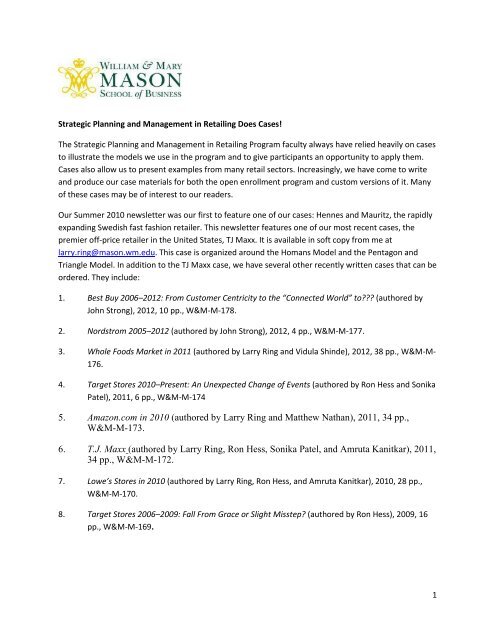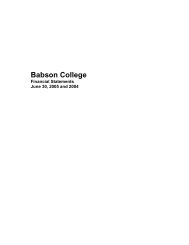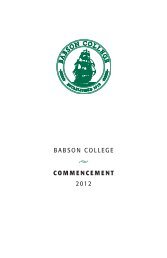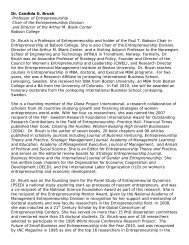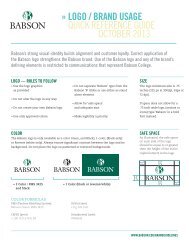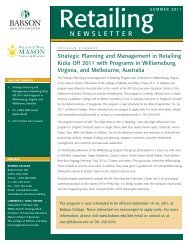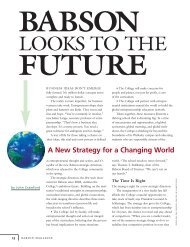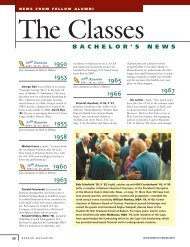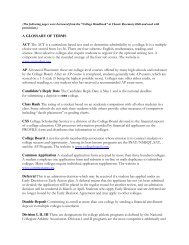TJ Maxx - Babson College
TJ Maxx - Babson College
TJ Maxx - Babson College
Create successful ePaper yourself
Turn your PDF publications into a flip-book with our unique Google optimized e-Paper software.
Strategic Planning and Management in Retailing Does Cases!<br />
The Strategic Planning and Management in Retailing Program faculty always have relied heavily on cases<br />
to illustrate the models we use in the program and to give participants an opportunity to apply them.<br />
Cases also allow us to present examples from many retail sectors. Increasingly, we have come to write<br />
and produce our case materials for both the open enrollment program and custom versions of it. Many<br />
of these cases may be of interest to our readers.<br />
Our Summer 2010 newsletter was our first to feature one of our cases: Hennes and Mauritz, the rapidly<br />
expanding Swedish fast fashion retailer. This newsletter features one of our most recent cases, the<br />
premier off-price retailer in the United States, <strong>TJ</strong> <strong>Maxx</strong>. It is available in soft copy from me at<br />
larry.ring@mason.wm.edu. This case is organized around the Homans Model and the Pentagon and<br />
Triangle Model. In addition to the <strong>TJ</strong> <strong>Maxx</strong> case, we have several other recently written cases that can be<br />
ordered. They include:<br />
1. Best Buy 2006–2012: From Customer Centricity to the “Connected World” to??? (authored by<br />
John Strong), 2012, 10 pp., W&M-M-178.<br />
2. Nordstrom 2005–2012 (authored by John Strong), 2012, 4 pp., W&M-M-177.<br />
3. Whole Foods Market in 2011 (authored by Larry Ring and Vidula Shinde), 2012, 38 pp., W&M-M-<br />
176.<br />
4. Target Stores 2010–Present: An Unexpected Change of Events (authored by Ron Hess and Sonika<br />
Patel), 2011, 6 pp., W&M-M-174<br />
5. Amazon.com in 2010 (authored by Larry Ring and Matthew Nathan), 2011, 34 pp.,<br />
W&M-M-173.<br />
6. T.J. <strong>Maxx</strong> (authored by Larry Ring, Ron Hess, Sonika Patel, and Amruta Kanitkar), 2011,<br />
34 pp., W&M-M-172.<br />
7. Lowe’s Stores in 2010 (authored by Larry Ring, Ron Hess, and Amruta Kanitkar), 2010, 28 pp.,<br />
W&M-M-170.<br />
8. Target Stores 2006–2009: Fall From Grace or Slight Misstep? (authored by Ron Hess), 2009, 16<br />
pp., W&M-M-169.<br />
1
9. Starbucks (B): Period of Poor Strategic Decisions (authored by Ron Hess), 2009, 4 pp., W&M-M-<br />
168.<br />
10. Hennes and Mauritz (authored by Larry Ring and Rachel Hutson), 2009, 21 pp.,<br />
W&M-M-167.<br />
11. Zara in 2007 (authored by Larry Ring and Elizabeth Galloway), 2008, 21 pp., W&M-M-<br />
164.<br />
12. Target Stores in 2006 (authored by Larry Ring, Gregory Higgins, and Xiaobing Nie),<br />
2007, 30 pp., W&M-M-159.<br />
13. Best Buy 1996–2005 (authored by John S. Strong), 2005, 9 pp., W&M-M-158.<br />
14. The Gap, 1999–2002 (authored by Larry Ring), 2005, 9 pp., W&M-M-156.<br />
15. The Home Depot, 2000–2005 (authored by Larry Ring, John Strong, and Yelena<br />
Shekhovtsova), 2005, 26 pp., W&M-M-154.<br />
2
Introduction<br />
<strong>TJ</strong> <strong>Maxx</strong> a<br />
W&M-M-172<br />
<strong>TJ</strong>X Corporation, the parent of off-price retailer, T J <strong>Maxx</strong>, reported Return on Shareholder’s<br />
Equity (ROE) of 42 percent on January 31, 2010. This was the highest ROE of all major United<br />
States retailers for the calendar year 2009, and was the sixth consecutive year that <strong>TJ</strong>X led the<br />
other big U.S. retailers in profitability.<br />
Each year, the question is raised again: Could the company continue to post such outstanding<br />
results in the future? <strong>TJ</strong>X had performed very well before the Global Financial Crisis (GFC) and<br />
during the GFC. As the world’s economies struggled to return to normalcy, many wondered if<br />
<strong>TJ</strong>X could continue to thrive or if the more price- and- cost- conscious behavior of other retailers<br />
would render off-pricers less effective.<br />
The off-price retail sector had grown faster than most other retail segments, with a CAGR greater<br />
than 10 percent during the latter half of the 2000’s decade, well above the 4 percent average<br />
annual growth rate for apparel retail. This ongoing trend reflected consumer preference for<br />
brand-name fashion at prices lower than those found at full-price department stores. The<br />
combination of a simultaneously growing demand and supply in the off-price market led to this<br />
10 percent growth in this sector. <strong>TJ</strong>X rode this growth wave as it expanded its operations<br />
throughout the U.S., Canada, England, Scotland, and Ireland. <strong>TJ</strong>X owned T.J. <strong>Maxx</strong> and<br />
Marshalls, together known as Marmaxx. Ross Stores was the second-largest off-price retailer in<br />
the U. S. in terms of total sales. 12 As the U.S. economy struggled through the impact of the subprime<br />
fallout and the GFC, consumers cut-back on all apparel and fashion spending. Even as the<br />
economy emerged from the recession, retailers across all segments of the soft goods sector<br />
predicted that the deal-seeking behavior of consumers would stick around. Therefore, the upscale<br />
department stores and the branded retailers were leading with their outlet stores as they battled<br />
for the discount-driven shoppers.<br />
a This case was prepared by Sonika Patel, MBA 2011, and Amruta Kanitkar, MBA 2010, under the supervision of<br />
Lawrence J. Ring, Chancellor Professor of Business and EMBA Alumni Professor and Ron Hess, Associate Professor,<br />
as a basis for class discussion. It is not intended to illustrate either effective or ineffective management. Copyright,<br />
2011, by the Mason School of Business Foundation Board.<br />
3
Nordstrom and Saks Fifth Avenue both increased their outlet store base at a faster pace than their<br />
full-line fleet. Macy’s planned to enter the outlet concept for its Bloomingdale’s nameplate with<br />
four outlet locations in Florida. Lord & Taylor focused on its nascent outlet concept after having<br />
failed in its attempt to go upscale. They also focused on the online outlet storefront on eBay.com.<br />
Burlington Coat Factory invested in improving the store experience after doing a consumer<br />
survey. They refreshed 26 stores with new carpet, painting, and fitting room improvement.<br />
A snapshot of this sector showed that Nordstrom was snatching customers from Neiman Marcus<br />
and Saks Fifth Avenue (SAKS), and T.J.<strong>Maxx</strong> and Marshalls (<strong>TJ</strong>X) were stealing market share<br />
from almost every store in the mall. And Macy’s benefited as much as it got hurt when shoppers<br />
headed to off-price discount stores. Full-price stores were trying to make money by expanding<br />
their discount outlets as their same store sales growth was declining.<br />
Going forward, some observers wondered if the off-price retailers would be challenged by the<br />
full-price retailers tightening their hold on inventories. Also, some thought the widespread<br />
adoption of retail technologies and the development of other branded retailers’ clearance<br />
channels would be a threat to the off-price retailers.<br />
How Off Price Works<br />
The typical off-price customer was a treasure hunter who visited a store like T.J.<strong>Maxx</strong> as often as<br />
weekly in search of getting a great deal on designer outfits and accessories from a previous<br />
season or that had been featured at a more prestigious retailer at a much higher price. It is<br />
generally assumed that off-price stores sell brand-name clothing, jewelry, luggage’ and other<br />
items found in conventional retailers, but at far lower prices. They can do this, in part, because<br />
they sell merchandise from a previous year or season that a store or brand couldn’t sell and<br />
unloaded for pennies on the dollar to a liquidator. 3 This is the conventional wisdom.<br />
<strong>TJ</strong>X CEO Carol Meyrowitz says there is more to it than that. She says that 85 percent of what the<br />
stores (T.J.<strong>Maxx</strong> and Marshall’s) sell is from the same season and same year it was designed for,<br />
and that 85 percent is purchased directly from manufacturers. Much is identical to what the<br />
brands sell in department stores and less than 5 percent is irregular. 4<br />
Meyrowitz says <strong>TJ</strong>X typically deals directly with brands—not with liquidators. Many brands<br />
deny such arrangements. ―We’re absolutely fine with every vendor saying they don’t do business<br />
with us,‖ Meyrowitz says. ―It’s a very important part of our relationship. She says manufacturers<br />
like doing business with her company because ―we’re not fair-weather friends. When we buy it,<br />
we own it.‖ <strong>TJ</strong>X is there to help when stores buy too much and return unsold merchandise to<br />
manufacturers, but also when manufacturers and designers want to lower their per-item cost by<br />
making extra money for the company’s stores. 5<br />
4
History<br />
In 1976, a young and talented merchant, Ben Cammarata, previously general merchandise<br />
manager of Marshalls, was offered an opportunity to build a new off-price chain. Under his<br />
leadership T.J.<strong>Maxx</strong> was born, a subsidiary of the <strong>TJ</strong>X Companies Inc.<br />
The first two T.J.<strong>Maxx</strong> stores opened in Auburn and Worcester, Massachusetts. They offered<br />
off-price, upscale apparel for the whole family. T.J.<strong>Maxx</strong> was an instant hit with customers<br />
including middle- to upper-middle-income shoppers, providing the perfect solution to the<br />
heightened demand for quality fashions at reasonable prices with an ever-changing fresh<br />
assortment and hence earned the slogan ―Never the same place twice.‖ 6<br />
By the mid-1980s, off–price specialty retailing gained ground, and, by 1986, 35 new T.J.<strong>Maxx</strong><br />
stores were opened. By 1991, T.J.<strong>Maxx</strong> was by far the company’s largest division, and posted<br />
record sales for the 15 th consecutive year since it opened. At the end of 1991, T.J.<strong>Maxx</strong> had 437<br />
stores in 46 states. Company executives planned to open many more stores, focusing primarily<br />
on the sparsely penetrated southwestern United States, as well as expanding several existing<br />
stores. T.J. <strong>Maxx</strong> also planned to follow its success in jewelry and shoes by opening these<br />
respective departments at locations that did not carry these items. It also planned to expand its<br />
high performance nonapparel categories, such as giftware and domestic items. In addition,<br />
T.J.<strong>Maxx</strong> embarked on an effort to enlarge a number of stores to a larger format ranging from<br />
30,000 to 40,000 square feet. This effort facilitated expansion of all the departments, especially<br />
giftware and houseware, as well as other nonapparel categories. T.J.<strong>Maxx</strong> opened 21 stores<br />
during 1996 and closed 30.The chain recorded excellent sales in 1996, an increase of 5 percent<br />
from the previous year. 7<br />
In 1995, Marshalls was acquired, and T.J. <strong>Maxx</strong> together with Marshalls formed the Marmaxx<br />
Group, the largest off-price retailer of apparel and home fashions in the U.S. Despite the<br />
similarities in operations, T.J.<strong>Maxx</strong> and Marshalls retained their distinct identities.<br />
In 1998, <strong>TJ</strong>X launched A.J.Wright in eastern U.S., and went national in 2004 when it opened its<br />
first store in California.<br />
In 2002, <strong>TJ</strong>X revenue was approximately $12 billion and grew to $13 billion by the end of 2003.<br />
In 2004, the company was ranked 141 st in the Fortune 500 rankings with almost $15 billion in<br />
revenue. 8<br />
At the end of 2008, T.J.<strong>Maxx</strong> operated 874 stores and anticipated further growth opportunities in<br />
the U.S., including new stores and expansion of successful merchandise categories. 9 Exhibit 1<br />
displays the number and location of <strong>TJ</strong>X stores by division.<br />
<strong>TJ</strong>X Companies reported sales on January 31, 2010, of $ 20.288 billion and Return on Net Worth<br />
of 42 percent. Exhibit 2 provides the company’s Income Statement and Exhibit 3 provides the<br />
Balance Sheet.<br />
5
<strong>TJ</strong>X Company Vision and Values:<br />
According to its website, the <strong>TJ</strong>X Company’s long-term vision was to grow as a global offprice/value<br />
company. The company mission was to deliver great value to customers. The value<br />
for customers had four components: Fashion, quality, brand, and price 10<br />
In 2007, <strong>TJ</strong>X adopted a new vision, Company of Choice in which every customer and associate<br />
felt valued and found value. A Company of Choice means:<br />
� <strong>TJ</strong>X businesses are each a Retailer of Choice for increasingly diverse and international<br />
customer and vendor communities<br />
� <strong>TJ</strong>X is an Employer of Choice for increasingly diverse and international talent<br />
� <strong>TJ</strong>X is a Neighbor of Choice in supporting the neighborhoods and communities where its<br />
stores, distribution centers, and offices are located 11<br />
Since its adoption, <strong>TJ</strong>X had made significant progress to achieve this vision. In 2008, as a<br />
Retailer of Choice, <strong>TJ</strong>X improved the in-store shopping experience of its customers by providing<br />
more bilingual Spanish-English signs and offering larger, family-friendly dressing rooms. As an<br />
Employer of Choice, <strong>TJ</strong>X improved its employee benefits offerings and granted same-sex<br />
domestic partner benefits to associates. As a Neighbor of Choice, The <strong>TJ</strong>X Foundation and <strong>TJ</strong>X<br />
Community Relations invited associates to stores, offices, and distribution centers to recommend<br />
organizations with which <strong>TJ</strong>X could partner. This activity made charitable efforts more localized<br />
and meaningful for both the <strong>TJ</strong>X associates and customers.<br />
Core Values:<br />
The <strong>TJ</strong>X Companies were committed to the values of integrity and treating people with respect,<br />
dignity, and fairness. <strong>TJ</strong>X was constantly trying to improve the ways in which it could embrace<br />
and leverage the differences among its people. The company believed in delivering value to<br />
customers while returning value to its shareholders. At the executive and board level and<br />
throughout the organization, the company was committed to strengthening its position as a<br />
Company of Choice. 8<br />
The core values of the company were as quoted below:<br />
―We believe that the diversity within our workforce and vendor base makes us a better company,<br />
and realize that our work must continue in order to meet and exceed the expectations of our<br />
increasingly diverse customers, associates, vendors, and communities.‖ 9<br />
6
Corporate Social Responsibility:<br />
To ensure that the core values of integrity and openness continued to be an integral part of the<br />
company culture, <strong>TJ</strong>X introduced a global Corporate Social Responsibility program, Always<br />
about V.A.L.U.E. 10 Each letter in the word value stood for one of the five tenets of social<br />
responsibility that <strong>TJ</strong>X identified as having the most meaning for the company. Those areas<br />
were: Vendor Social Compliance, Attention to Governance, Leveraging Differences, United with<br />
Our Communities, and Environmental Initiatives. This program aimed to help <strong>TJ</strong>X to continue to<br />
make a positive, sustainable impact with its shareholders, associates, customers, vendors, and<br />
communities.<br />
Organizational Structure<br />
<strong>TJ</strong>X’s corporate structure was very hierarchical with board of directors at the top, including<br />
Chairman of the Board Bernard Cammarata and President and CEO Carol Meyrowitz. See<br />
Exhibit 4A for the complete organization structure led by Meyrowitz. Following the board, were<br />
the executive officers that include the CFO and senior VPs. The board and executives were<br />
further grouped by functions into committees. See Exhibit 4B for the business structure of <strong>TJ</strong>X.<br />
Management Style:<br />
The corporate culture at <strong>TJ</strong>X was very family-like and had an open-door policy. <strong>TJ</strong>X was<br />
founded on the core values of integrity and treating people with respect and integrity. The <strong>TJ</strong>X<br />
culture encouraged respect for each individual which was evident from its philosophy of<br />
Remember Everyone Affects Customer Happiness (REACH). This emphasized the company’s<br />
dedication to providing consumers, vendors, and co-workers with a level of caring beyond what<br />
is expected.<br />
Every employee was encouraged to share his or her viewpoint and the open-door policy ensured<br />
that all perspectives were heard and valued. The company had four authorized associate groups.<br />
These Associate Resource Groups were provided an annual operating budget and a liaison from<br />
Human Resources. These were groups to which any associate may belong, offering associates<br />
networking and career development support, business information and education, and offering<br />
the company ideas to help it achieve its goals as an Employer of Choice.<br />
Management Systems: The company provided competitive packages and benefits such as life<br />
and home insurance, medical dental, college savings program, and scholarship awards program.<br />
Additionally, the company provided on-site day care center, dry cleaning, career development<br />
library, and learning and development training classes. At <strong>TJ</strong>X, management believed that a<br />
work-life balance was critical to the successes of the associates, and thus encouraged the<br />
associates to have one.<br />
7
Leveraging differences, diversity, and equity was given serious thought and importance at <strong>TJ</strong>X.<br />
Company management development courses about leading teams and giving feedback addressed<br />
how to manage the differences among associates. Team development programs addressed<br />
differences that could impact associates as they worked together. In addition, tailored programs<br />
related to leveraging differences and diversity to support a particular group or business unit were<br />
created and offered as business objectives warranted. In Canada, a program titled The Equitable<br />
Leader was offered to leaders throughout the Canadian businesses. In the U.S., new opportunities<br />
for managers to develop core skills for leveraging differences and managing for inclusion were<br />
being designed. 12<br />
Pentagon Components:<br />
Place:<br />
Store Size: By 2009, T.J.<strong>Maxx</strong> had 874 stores in 48 states in the US. The average year-on-year<br />
growth in terms of the number of stores was 3 percent. The average store size was 30,000 square<br />
feet. 13<br />
Store Location: T.J.<strong>Maxx</strong> stores were generally located in suburban community shopping<br />
centers. <strong>TJ</strong>X leased nearly all its store locations generally for 10 years with an option to extend<br />
the lease for one or more five-year periods. It had the right to terminate some of these leases<br />
before the expiration date under specified circumstances and for specific payments. 14 <strong>TJ</strong>X<br />
operated 13 distribution centers in the U.S., two in Canada, and four in U.K. that together<br />
accounted for approximately 11 million square feet. All of the merchandise was shipped to stores<br />
through one of the large and highly automated distribution centers. In 2010, the company<br />
shipped about 1.6 billion units to stores. Exhibit 5 provides locations for <strong>TJ</strong>X distribution<br />
centers for 2010.<br />
Layout and Design: T.J.<strong>Maxx</strong> operated with a low-cost structure as compared to many other<br />
retailers. While the company endeavored to provide a pleasant, easy shopping environment with<br />
an emphasis on customer convenience, it did not spend heavily on store fixtures. T.J.<strong>Maxx</strong> had<br />
an open floor plan. The selling space was flexible without walls between departments and largely<br />
free of permanent fixtures. As a result, management could easily contract or expand departments<br />
in response to customer demand, available merchandise, and fashion trends. 15 The typical store<br />
characteristic was its treasure hunt atmosphere. The Runway designer department within the<br />
store was set apart with softer lighting, lavender signage, and sleek black and lavender fixtures. 16<br />
Lifestyle signs designating Active shop, Swim shop, or Dress shop were prominently displayed<br />
so that shoppers could easily navigate the store. 17<br />
Product:<br />
Intensity: The high sales-per-square-foot productivity and rapid inventory turnover provided<br />
expense efficiencies to the chain. 18<br />
8
<strong>TJ</strong>X had an exceptional inventory management system. Maintaining low inventory levels to<br />
drive faster inventory turns was one of the key strategies of the company. This enabled the<br />
company to maintain higher merchandise margins even during a difficult retail environment. In<br />
2010, the company planned to invest further in its supply chain to ensure that the right<br />
merchandise flowed to the right stores at the right time.<br />
The merchandise intensity graph indicated that the inventory management improved from 2007<br />
to 2010. This meant that less inventory was required per selling square foot. This shows that <strong>TJ</strong>X<br />
is tying up fewer dollars in inventory. The table for this graph is in Exhibit 6 and shows the<br />
corporate numbers along with those of each division.<br />
Assortment: T.J.<strong>Maxx</strong> primarily targeted female shoppers who had families with middle to<br />
upper-middle incomes and who generally fit the profile of a department or specialty store<br />
customer. T.J.<strong>Maxx</strong> sold brand-name family apparel, women’s shoes, and home fashions and<br />
differentiated itself with an expanded assortment of fine jewelry and accessories, all at prices 20-<br />
60 percent below department and specialty store regular prices. 19 The jewelry and accessories<br />
department performed well and by fiscal 2007, 686 out of total 821 stores completed the<br />
expansion of this department. 20 In 2006, better off-price buying was made a key priority and <strong>TJ</strong>X<br />
shifted approximately 10 percent of its buying dollars into more off-price, close-out buys. This<br />
change improved the flow of great brands at compelling values to the stores every day, upped the<br />
―WOW‖ factor, and increased the excitement of the treasure hunt experience. Merchandising<br />
initiatives such as The Runway designer departments featured higher-end designer fashions<br />
including overruns, onesies, and twosies. The designer section was tested in 40 T.J.<strong>Maxx</strong><br />
stores. 21 The Runway assortment focused on higher-priced designer, contemporary, and<br />
premium-denim brands which would not play well in all the markets and hence by 2008<br />
T.J.<strong>Maxx</strong> confined the rollout to 50 stores and was selectively adding more assortments to more<br />
stores. T.J.<strong>Maxx</strong> continued to focus on growing categories such as jewelry, including the<br />
addition of staffed jewelry counters, across all the stores. The company also capitalized on the<br />
9
popularity of active wear beyond its functionality for exercising or playing a sport. It offered<br />
active wear in both performance and athleisure brands. 22 T.J.<strong>Maxx</strong> leveraged the downturn in<br />
department store sales through opportunistic buying and as a result had more in-season and ontrend<br />
merchandise. Dresses in particular were strong sellers for spring and summer. Accessory<br />
and jewelry sales were robust as well, especially designer handbags. 23<br />
Style and Fashion: The Runway department at T.J.<strong>Maxx</strong> offered designer brands such as Coach,<br />
J Brand, Joe’s Jeans, Elie Tahari, Vivienne Tam, Vera Wang, Lavender Label, Theory,<br />
Moschino, Valentino, Ralph Lauren, and many more. 24 As a consequence, T.J.<strong>Maxx</strong> was often<br />
viewed by customers as very much in fashion and competitive in fashionability with department<br />
and specialty stores.<br />
Value:<br />
Price:<br />
<strong>TJ</strong>X Companies followed the off-price business model, which made branded fashion available to<br />
customers at a more affordable price. The company operated eight off-price retail chains in the<br />
U.S., Canada, and Europe and was known for its treasure hunt shopping experience and excellent<br />
values on brand-name merchandise.<br />
<strong>TJ</strong>X Companies was differentiated from traditional retailers because of its opportunistic buying<br />
of quality brand-name merchandise. A majority of its apparel inventory and a significant portion<br />
of its home fashion inventory were purchased opportunistically and virtually its entire inventory<br />
was purchased at discounts from initial wholesale prices.<br />
This off-price model allowed the pricing strategy to be very flexible and allowed the company to<br />
react to market trends easily. The opportunistic buying and inventory management strategy<br />
helped the company to keep its assortments more current and turn the inventory more rapidly.<br />
This model gave it great flexibility to adjust pricing to the current market more frequently than<br />
other retailers.<br />
The pricing and markdown decisions were made centrally, using information provided by<br />
specialized computer systems. The company generally did not engage in promotional pricing.<br />
Also, the low-cost operational structure of the company allowed it to maintain high margins<br />
while offering brand-name merchandise to its customers at a low price. The company focused<br />
aggressively on cost savings in areas such as nonmerchandise procurement, operating<br />
efficiencies in distribution centers and stores, and efficiencies in supply chain.<br />
Quality:<br />
<strong>TJ</strong>X was able to obtain adequate amounts of quality inventory for its customers irrespective of<br />
how favorable or difficult the retail environment was.<br />
<strong>TJ</strong>X essentially sourced its inventories, at substantial discounts, due to order cancellations and<br />
manufacturer overruns. This happened regularly in a highly fragmented apparel and home<br />
10
fashion industry. Therefore, there was no compromise on the quality of the product since it was<br />
sourced directly from the manufacturer. The merchandise carried either a manufacturer’s label or<br />
another retailer’s label. It was the same quality provided to customers at a more affordable price<br />
that created value for the customers. A small percentage of the merchandise was private label<br />
merchandise which was produced specifically for <strong>TJ</strong>X by third-party manufacturers.<br />
<strong>TJ</strong>X purchased less-than-full assortments of items, styles, and sizes which attracted the<br />
manufacturers toward <strong>TJ</strong>X in the case of unplanned excess inventory. However, the company<br />
ensured that its product assortment followed the changing consumer trends. Its efficient<br />
inventory cycle helped it manage the quality of their assortment and keep up to date.<br />
<strong>TJ</strong>X competed on the basis of fashion, quality, price, value, merchandise selection and freshness,<br />
brand-name recognition, service, reputation, and store location. In order to drive traffic to the<br />
stores and to increase same-store sales, the treasure hunt nature of the off-price buying<br />
experience required continued replenishment of fresh, high-quality, and attractively priced<br />
merchandise in the stores.<br />
It was this quality merchandise mix and affordable pricing that maximized the value <strong>TJ</strong>X offered<br />
to its customers.<br />
People:<br />
Service:<br />
Although <strong>TJ</strong>X primarily offered a self-service format, the company trained its store associates to<br />
provide friendly and helpful customer service. It also had customer-friendly return policies.<br />
Customer feedback was essential to ensure that they kept coming back to the store. Therefore,<br />
both T.J. <strong>Maxx</strong> and Marshalls had a website that included an email address and a toll-free<br />
telephone number that directed feedback, suggestions, or concerns directly to the Customer<br />
Service Group of <strong>TJ</strong>X.<br />
<strong>TJ</strong>X had in-house service groups dedicated to answering and facilitating customer inquiries.<br />
From time to time, the marketing websites also offered customers an option to fill online<br />
customer satisfaction surveys. These surveys gave direct feedback on customer experience, the<br />
merchandise mix or the service customers received in the store.<br />
<strong>TJ</strong>X also conducted in-store, customer-service programs to motivate and reward associates,<br />
stores, and store districts. These programs helped to educate and motivate quality in customer<br />
service so that the customers had a great shopping experience, irrespective of which <strong>TJ</strong>X store<br />
they chose to shop.<br />
Employee Climate:<br />
<strong>TJ</strong>X proudly called itself the Employer of Choice, and welcomed talent from diverse<br />
backgrounds. By the end of 2009, <strong>TJ</strong>X had approximately 154,000 associates comprising 75<br />
11
percent women and more than 50 percent minorities. The management team was comprised of<br />
about 60 percent women and nearly 30 percent minorities. 25<br />
<strong>TJ</strong>X’s compensation for its executive officers was based on the philosophy of pay for<br />
performance. Total compensation was a combination of base salary, short-term and long-term<br />
cash incentives, and long-term, equity-based incentives.<br />
<strong>TJ</strong>X had various programs that focused on leveraging new and existing people in the company.<br />
The Merchandise Manager Program and the <strong>TJ</strong>X Off-Price Leadership Center focused on the<br />
individual development of current talent and new talent brought from outside the organization.<br />
For new associates pursuing merchandising and planning careers, the <strong>TJ</strong>X Corporate<br />
Merchandise Training Program (CMTP) was the best-in-class, retail-training program. <strong>TJ</strong>X also<br />
had a major hub of learning where it focused on strengthening and developing employees in the<br />
areas of operations, merchandising, planning, and leadership. 26<br />
<strong>TJ</strong>X extended its benefits offerings and also granted same-sex domestic partner benefits to its<br />
associates. <strong>TJ</strong>X scored 100 on the Corporate Equality Index of the Human Rights Campaign for<br />
both 2009 and 2010, earning a special green place in the Human Rights Campaign Buying Guide<br />
in both the guide for holiday season 2008 and 2009. 27<br />
In spring 2010, <strong>TJ</strong>X was ranked No. 6 in the Specialty Retail Category Ranking in Fortune’s<br />
annual list of Most Admired Companies. <strong>TJ</strong>X moved up three places from No. 9 in 2009.<br />
Customer Climate:<br />
<strong>TJ</strong>X was constantly finding ways to serve its diverse customer base and enhance their shopping<br />
experience. To that end, <strong>TJ</strong>X started upgrading stores across all of their businesses. In 2009, <strong>TJ</strong>X<br />
started an extensive remodeling program for Marmaxx, and expected to have 700 stores ready by<br />
the end of fall 2010. 28<br />
<strong>TJ</strong>X also added bilingual Spanish-English signs and improved the overall look of their signage.<br />
The dressing rooms were made more spacious to help larger families and busy moms shop more<br />
conveniently.<br />
At both T.J. <strong>Maxx</strong> and Marshalls, there was a dedicated group for store planning that worked<br />
toward offering a better merchandising mix to their customers. This group identified differences<br />
among customers and helped the company to better understand the changing needs of their<br />
customers. Also, the stores had no walls between departments, which allowed them to shift<br />
product assortments quickly as customers’ tastes changed.<br />
Communication:<br />
In 2009, <strong>TJ</strong>X ran an integrated marketing campaign for T.J. <strong>Maxx</strong> and Marshalls to convince<br />
recession-struck women that they could afford the expensive fashion brands.<br />
12
The advertising spot showed fashion-conscious women chasing their errant friends and<br />
cautioning them as they overspent by paying full price for their clothes. The campaign<br />
questioned women asking if they are ready to take the first step toward such shopping<br />
interventions. One of the reasons why many people did not shop at both T.J. <strong>Maxx</strong> and Marshalls<br />
is because they do not understand the concept of off-price. Therefore, the best way to educate<br />
these consumers would be through their friends who know about it. This commercial ran on TV<br />
in major markets.<br />
In addition, the company also claimed to save fashionistas $1 billion from January 2009 to April<br />
2009, compared to the department and specialty store prices. 29<br />
To support the TV communication, <strong>TJ</strong>X also executed some guerilla marketing efforts where<br />
actors performed spending interventions. Billboards featuring the TV spots and items currently<br />
in stock were rolled out in these nine major cities: New York, Boston, Los Angeles, Chicago,<br />
Philadelphia, Washington, D.C., Atlanta, San Francisco, and Miami.<br />
In 2010, <strong>TJ</strong>X continued to push the concept of smart shopping and educated shoppers about the<br />
opportunity to save money with new commercials for Marshalls: ―Never pay full price for<br />
fabulous.‖ The commercial showed how women could save money on designer cashmere<br />
sweaters.<br />
As consumers became aware about this ―shopportunity,‖ <strong>TJ</strong>X hoped to get consumers excited<br />
about its products even before they entered the stores. The company also used social media and<br />
had about 300,000 Facebook fans for T.J. <strong>Maxx</strong> and about 270,000 for Marshalls.<br />
Also, both had a website that allowed shoppers to comment on their products and share their<br />
experiences. Additionally, what made these websites more exclusive was the fact that customers<br />
could not buy anything online. The website showed the prices and reviews on products but did<br />
not include online shopping. This showed how <strong>TJ</strong>X was trying to build a community among its<br />
consumers who closely associate with the brand.<br />
However, <strong>TJ</strong>X operated on a low-cost structure model. Therefore, it spent less on its advertising<br />
budget as a percentage of sales compared to traditional retailers. This potentially provided<br />
competitors with large spending budgets a huge competitive advantage. The advertising costs as<br />
a percentage of net sales for <strong>TJ</strong>X had marginally dropped from 2008 to 2010. Advertising<br />
expense was $227.5 million for fiscal 2010, $254 million for fiscal 2009 and $255 million for<br />
fiscal 2008.<br />
2010 2009 2008<br />
Net sales $ 20,288,444,000 18,999,505,000 18,336,726,000<br />
Advertising<br />
Expense $<br />
Advertising as<br />
% of Sales<br />
227,500,000 254,000,000 255,000,000<br />
1.12% 1.34% 1.39%<br />
13
T.J.<strong>Maxx</strong> Overall Image<br />
In 2007, Opinion Research Corporation completed a major survey on off-price retailers and their<br />
competitors. In that research, T.J.<strong>Maxx</strong> received significant consideration. The company’s<br />
overall image on various pentagon components can be depicted as follows:<br />
<strong>TJ</strong> <strong>Maxx</strong> Image Profile: Total Rep Sample<br />
Usage (n=2269)<br />
Shopped Past 6 Months – 37%<br />
Shopped Most Often – 5%<br />
Offer competitive prices<br />
Offer the lowest prices<br />
Offer best value on merchandise<br />
Easy to get in and out of store quickly<br />
Best discounts top American/European brand names<br />
Carry quality, popular brand names<br />
Offer an easy return policy<br />
Carry conservative, everyday fashions<br />
Carry ‗classic‘ apparel and accessories<br />
Easy to find what you are looking for<br />
Carry current, up-to-date fashions<br />
Ability to buy coordinated outfits at same store<br />
Carry top American/European brand names<br />
Clean, uncluttered shopping atmosphere<br />
Offer unique fashion merchandise<br />
Largest apparel merchandise assortment/selection<br />
Have knowledgeable sales clerks<br />
Offer personal service/helpful sales clerks<br />
Prestigious, upscale reputation<br />
1<br />
37<br />
30<br />
30<br />
28<br />
28<br />
26<br />
18<br />
17<br />
17<br />
16<br />
15<br />
15<br />
12<br />
12<br />
8<br />
8<br />
4<br />
C1 Out of (READ RETAIL STORE NAMES), which of them are stores that (READ 1 ST ATTRIBUTE). Any others from the list? You may mention as many or as few as you think apply?<br />
The Triangle Components:<br />
51<br />
49<br />
(Base: n=1960)<br />
Systems: The efficient operation of the <strong>TJ</strong>X business was dependent on its information systems,<br />
including its ability to operate them effectively and successfully to implement new technologies,<br />
systems, controls, and adequate disaster recovery systems.<br />
In 2007, <strong>TJ</strong>X had the largest customer data security breach on record in which 45 million T.J.<br />
<strong>Maxx</strong> and Marshall’s customers’ credit and debit card numbers were stolen during an 18-month<br />
period. 30 In one of its earnings reports, <strong>TJ</strong>X estimated noncash charges of about $21 million after<br />
tax. These charges were recorded in fiscal 2009. <strong>TJ</strong>X recorded a reserve that reflected the<br />
estimation of probable losses arising from the computer intrusion in accordance with generally<br />
accepted accounting principles. This reserve represented the best estimate of total, potential cash<br />
14
liabilities from litigation, proceedings, investigations, and other claims, as well as legal and other<br />
costs and expenses, arising from the computer intrusion. 31<br />
Since discovering the computer intrusion, <strong>TJ</strong>X took steps designed to further strengthen the security<br />
of its computer system and protocols and instituted an ongoing program with respect to data security.<br />
Logistics and Distribution: One of the key strengths of <strong>TJ</strong>X included very efficient inventory<br />
management systems and distribution networks specific to the off-price business model. The<br />
company maintained a liquid inventory position and buyers bought close to the need. The vast<br />
majority of the merchandise came directly from the manufacturers with some from retailers and<br />
other sources. The company relied heavily on sophisticated internally developed inventory<br />
systems and controls that permitted a continuous flow of merchandise into the stores. The<br />
expansive distribution infrastructure supported close-to-need buying by delivering the goods to<br />
the stores quickly and efficiently.<br />
The company’s highly automated storage and distribution systems tracked, allocated, and<br />
delivered an average of approximately 11,000 items per week to each T.J. <strong>Maxx</strong> and Marshalls<br />
store. In addition, specialized computer inventory planning, purchasing and monitoring systems,<br />
coupled with warehouse storage, processing, handling and shipping systems, permitted a<br />
continuous evaluation and rapid replenishment of store inventory. Pricing, markdown decisions,<br />
and store inventory replenishment requirements were determined centrally; using information<br />
provided by point-of-sale computer terminals and were designed to move inventory through the<br />
stores in a timely and disciplined manner. These inventory management and distribution systems<br />
allowed <strong>TJ</strong>X to achieve rapid in-store inventory turnover on a vast array of products and to sell<br />
substantially all merchandise within targeted selling periods. 32<br />
In 2001, <strong>TJ</strong>X installed a collaborative logistics application to help optimize its inbound and<br />
outbound merchandise transportation process. This tool enabled <strong>TJ</strong>X and its preferred vendors<br />
and carriers to collaborate in an interactive, online environment, and helped compress<br />
transportation planning and execution processes. This Web- and EDI-enabled application<br />
included robust planning and execution capabilities such as purchase order management,<br />
centralized transportation planning and load consolidation, carrier selection ,what-if scenario<br />
modeling, load tendering, freight payment, exception management, performance monitoring, and<br />
analysis capabilities. 33 Additionally, in order to gain better control of its transportation<br />
operations, <strong>TJ</strong>X deployed OptiBid Network solution to procure truckload transportation for<br />
inbound delivery of merchandise that it delivered to its more than 1,300 T.J. <strong>Maxx</strong>, Marshalls,<br />
HomeGoods and A.J.Wright stores across the U.S. The OptiBid Network considered all critical<br />
business factors, including freight variability, network flows, carrier rates, and service levels, and<br />
recommended an optimal strategic transportation plan. 34<br />
Cost Control was key to <strong>TJ</strong>X’s ability to offer substantial savings to the customer. Since<br />
transportation and logistics accounted for 10 percent of the final product cost in any industry, 35<br />
<strong>TJ</strong>X sought to maximize operational efficiencies by implementing sophisticated logistics and<br />
supply chain management tools.<br />
15
The company was environmentally conscious and was committed to incorporating efficient and<br />
environment-friendly initiatives when possible. The Transportation and Logistics Department<br />
spearheaded numerous initiatives to reduce fuel consumption and transportation costs through<br />
more efficient processes, including improving trailer-loading methods and reducing the number<br />
of trucks needed to transport goods.<br />
Suppliers:<br />
Supplier selection:<br />
<strong>TJ</strong>X had a corporate objective to provide great value to the customers. To that end, its suppliers<br />
were required to have a clear understanding of <strong>TJ</strong>X’s business requirements including:<br />
� Financial stability<br />
� Proven history of successful projects<br />
� Understanding of <strong>TJ</strong>X’s business and practices<br />
� Ability to provide high-quality, cost-competitive products and services<br />
� Acting in accordance with all applicable laws and regulations, in addition to maintaining<br />
the highest standards of business ethics<br />
For the suppliers, My<strong>TJ</strong>X.com provided access to secure, convenient and easy-to-use online<br />
tools, which allowed suppliers to conduct a number of business activities with <strong>TJ</strong>X, including<br />
registering the business.<br />
<strong>TJ</strong>X focused on leveraging differences and embracing diversity even at the supplier level. In<br />
1992, a supplier diversity program was started which encouraged the purchase of goods and<br />
services from minority- and women-owned businesses whose products and services met the need<br />
of the <strong>TJ</strong>X. 36<br />
Relationships: <strong>TJ</strong>X had more than 14,000 vendors that spanned 60 countries. In 2009,<br />
establishing new vendor relationships remained <strong>TJ</strong>X’s priority. With a merchant organization of<br />
more than 600 people, <strong>TJ</strong>X believed in supporting vendors, and worked hard at maintaining<br />
long-standing relationships with vendors. 37<br />
<strong>TJ</strong>X paid its vendors promptly, typically within 30 days, while other retailers took 60–90 days.<br />
<strong>TJ</strong>X didn’t try to negotiate with vendors for additional deals if the items were not sold. In a<br />
credit-strained environment, this was a critical selling point. These aspects not only helped <strong>TJ</strong>X<br />
establish superior relationships with vendors but also gave it a competitive advantage in getting a<br />
wider selection of items. 38<br />
<strong>TJ</strong>X has 700 buyers around the world that are part of what CEO Carol Meyrowitz calls a<br />
supplying machine. The company works with many factories and agents and maintains offices in<br />
countries including Italy, India, and China, she says. Buyers work with about 14,000 vendors in<br />
―a million different ways,‖ says Meyrowitz, who calls it ―opportunistic buying.‖ 39<br />
16
Competition: <strong>TJ</strong>X dominated the off-price retail category with two of the largest retail chains,<br />
T.J.<strong>Maxx</strong> and Marshalls. Consumers were always looking for value. The retail trend was moving<br />
toward consumers looking for bargain prices on department store-type branded, designer<br />
clothing. Hence, off-price retail stores like T.J.<strong>Maxx</strong>, Marshalls, and Ross were strong<br />
performers. Some of the big off-price retailers competing against <strong>TJ</strong>X were Ross, Filene’s<br />
Basement, Burlington Coat Factory, S&K, Syms, Steinmart, DSW, and Overstock.com (online).<br />
Ross: This company operated 922 Ross Dress for Less stores and 52 dd’s DISCOUNTS in the<br />
U.S. At both these chains, the company was focused on executing its off-price strategies to target<br />
the value-driven consumer. These stores offered everyday savings of 20 to 70 percent off<br />
department and specialty store regular prices. Ross Store’s off-price business model helped<br />
achieve strong financial results in FY2009 (sales and earnings growth of 8.6 percent and 17<br />
percent, respectively) in spite of a tough economic and retail climate. Sales for the year ended<br />
January 31, 2010, were $7.2 billion. Ross Stores Income Statement is presented in Exhibit 7 and<br />
its Balance Sheet is in Exhibit 8.<br />
Ross Stores offered a variety of merchandise. The mix of store products based on sales was as<br />
follows: ladies accessories (32 percent), home accents and bed and bath (23 percent), men’s<br />
accessories (14 percent), fine jewelry, accessories, lingerie, and fragrances (12 percent), shoes<br />
(10 percent), and children’s (9 percent). In addition to these categories, the company offered<br />
small furniture and furniture accents, educational toys and games, luggage, gourmet food and<br />
cookware, watches, and sporting goods. Ross Stores offered a large selection of brand names<br />
within each classification with a wide assortment of vendors, labels, prices, colors, styles, and<br />
fabrics. The company carried brand-name items ranging from GUESS, Michael Kors, Calvin<br />
Klein, DKNY, Lucky Jeans, Express, Ralph Lauren, Nike, Lacoste, and Timberland. A<br />
diversified product offering increased the company’s cross-selling opportunities and enhanced its<br />
revenue generation.<br />
An effective purchasing strategy was the key to the company’s off-price business model. Ross<br />
Stores had strong vendor relationships enhanced by the strategic location of buying offices in<br />
New York City and Los Angeles. The company sourced its merchandise from a network of<br />
approximately 7,200 merchandise vendors and manufacturers for both Ross and dd’s<br />
DISCOUNTS. 40<br />
Just like <strong>TJ</strong>X stores, Ross stores were conveniently located in community and neighborhood<br />
shopping centers in heavily populated urban and suburban areas. Depending on the size of the<br />
market, Ross stores were clustered to benefit from economies of scale in advertising,<br />
distribution, and field management.<br />
The store layouts and the shopping experience at Ross stores were very similar to those of<br />
T.J.<strong>Maxx</strong> or Marshalls. The company believed the key to its success was the organized,<br />
attractive, easy-to-shop, in-store environments at both Ross and dd’s DISCOUNTS that allowed<br />
customers to shop at their own pace. The stores promoted a self-service, treasure hunt shopping<br />
experience. The layouts were designed to promote customer convenience in their merchandise<br />
17
presentation; dressing rooms, checkout, and merchandise return areas. Each store’s sales area<br />
was based on a prototype single-floor design with a racetrack aisle layout. A customer could<br />
locate desired departments by signs displayed just below the ceiling of each department. The<br />
customers were able to select among sizes and prices through prominent category and sizing<br />
markers, promoting a self-service atmosphere. At most stores, shopping carts were available at<br />
the entrance for customer convenience. All cash registers were centrally located at store exits for<br />
customer ease and efficient staffing.<br />
Ross used point-of-sale (POS) hardware and software systems in all stores that minimized<br />
transaction time for the customer at the checkout counter by electronically scanning each ticket<br />
at the point of sale and authorizing personal checks and credit cards in a matter of seconds. In<br />
addition, the POS systems allowed Ross to accept debit cards and electronic gift cards from<br />
customers.<br />
Ross understood the significance of systems and technology, and continued to invest in both to<br />
drive growth. Some of the recent initiatives included:<br />
� Rollout of demand forecasting software and related process changes designed to<br />
strengthen merchandise planning effectiveness for Ross. This initiative was expected to<br />
drive a gradual increase in store sales productivity and profitability by improving their<br />
ability to plan, buy, and allocate product at a more local level.<br />
� Implementation of additional supply chain enhancements to support expansion and<br />
improvement of the supply chain network. They also implemented a new labor time and<br />
attendance system at all distribution centers.<br />
� Completion of the rollout of new tools to better support the continued growth of the<br />
import business. These new tools provided merchants with greater visibility into item<br />
cost components and inbound movement of import products.<br />
� Enhancements to POS systems were made to reduce customer transaction and wait times.<br />
� Implementation of enhanced labor scheduling capabilities to give the stores the ability to<br />
better align the workforce with in-store activities.<br />
� Upgrading of loss prevention software to allow for greater in-depth analysis and<br />
reporting. The company also invested in additional store video surveillance systems to<br />
provide centralized remote monitoring.<br />
� Implementation of new online tools to assist the stores in their recruiting and hiring<br />
efforts. These new tools were designed to help the store managers expedite the hiring<br />
process and increase the quality of hiring decisions.<br />
Ross had four distribution processing facilities, two in California and one each in Pennsylvania<br />
and South Carolina. They shipped all of their merchandise to the stores through these distribution<br />
18
centers, which were large, highly automated, and built to suit the specific off-price business<br />
model.<br />
In addition, they owned one and leased three other warehouse facilities for pack-away storage.<br />
They also used other third-party facilities as needed for storage of pack-away inventory. Ross<br />
also utilized third-party cross docks to distribute merchandise to stores on a regional basis.<br />
Shipments were made by contract carriers to the stores from three to six times per week,<br />
depending on location.<br />
In terms of communication, Ross relied primarily on television advertising to communicate the<br />
Ross value proposition: brand-name merchandise at low everyday prices. Ross management<br />
believed that television was the most efficient and cost-effective medium for communicating<br />
everyday savings on a wide selection of brand-name bargains for both the family and home.<br />
For 2010, Ross planned to maintain tight controls of both inventory levels and operating<br />
expenses as a part of its strategy to help maximize profitability. 41 Exhibit 9 compares <strong>TJ</strong>X and<br />
Ross in terms of sales, margin, and profit. Exhibit 10 compares <strong>TJ</strong>X and Ross and others on the<br />
Strategic Profit Model. Exhibit 11 compares <strong>TJ</strong>X and Ross on the Strategic Resource Model.<br />
Loehmann’s:<br />
Loehmann’s, a chain of upscale off-price department stores, was known for its Back Room. 42<br />
Company sales in 2009 were $422 million. 43 Fashion-conscious women went there to find<br />
designer clothes for prices lower than those in department or specialty stores. It carried a wide<br />
spectrum of looks favored by customers with classic to contemporary lifestyles. Store<br />
departments included ladies sportswear, dresses, career and casual collections, shoes,<br />
accessories, including handbags and jewelry, plus men’s, juniors, and children’s.<br />
Loehmann’s had more than 45 stores spread across 12 states and Washington, D.C., in the U.S. It<br />
had grown to include a large flagship store in Manhattan and one in Beverly Hills. The stores<br />
were filled with collections from top designer brands such as Calvin Klein, Diane Von<br />
Furstenberg, Kenneth Cole, Dolce & Gabbana, Valentino, Nicole Miller, Anne Klein, Donna<br />
Karan, Michael Kors, and more. 44<br />
Loehmann’s offered a Size Search in-store service that helped find and ship appropriate-sized<br />
items to customers and in select large stores where it also offered free personal shopping service.<br />
Loehmann’s also had an Insider Club for its customers. The club provided members extra<br />
savings opportunities, advance notice of sales and new designer arrival updates. Plus, Insider<br />
Club Gold members enjoyed additional exclusive benefits, including 10 percent off purchases<br />
every day for a low annual fee of $25. 45<br />
Loehmann’s went public in 1962 and since then had been on a financial roller-coaster. In 1983, it<br />
was acquired by Associated Dry Goods and was later sold to a Spanish investor group, Sefinco<br />
Ltd. In 1996, the company went public again and, in May 1999, it declared Chapter 11<br />
bankruptcy. In 2004, Loehmann’s was acquired by Arcapita, who sold it to Istithmar, a private<br />
equity firm based in Dubai, in 2006.<br />
19
On November 15, 2010, Loehmann’s filed for Chapter 11 bankruptcy again after failing to reach<br />
a debt extension with its creditors. It also announced the closing of at least eight stores. 46<br />
Filene’s Basement:<br />
Filene’s Basement, founded in 1909 by Edward Filene, was a Massachusetts-based chain of<br />
specialty stores offering assortments of fashionable, branded, and private label merchandise. The<br />
retailer operated about 25 upscale off-price stores in major cities such as Boston, New York,<br />
Washington, D.C., and Chicago. It distributed and replenished through a 470,000-square-foot<br />
distribution center in Auburn, Massachusetts. The stores offered off-price designer and brandname<br />
apparel, shoes, jewelry, and home goods for men and women.<br />
The company was known for its distinctive, low-technology automatic markdown system. The<br />
way the markdown originally worked was that ―every article was marked with a tag showing the<br />
price and the date the article was first put on sale. Twelve days later, if it had not been sold, it<br />
was reduced by 25 percent. Six selling days later, it was cut by 50 percent and after an additional<br />
six days, it was offered at 75 percent off the original price. After six more days, or a total of 30,<br />
if it was not sold, it was given to charity.‖ 47 The days between each markdown were eventually<br />
increased to 14 days and the system was followed only in select Filene’s Basement stores.<br />
In early 2009, the economic crisis had an effect on the chain, prompting the owner, Retail<br />
Ventures Inc. to close 11 of the chain’s 36 stores. Prior to closing the stores, Filene’s Basement<br />
had annual revenues of around $300 million. However, the closings did not help the company<br />
and, on May 4, 2009, the company filed a voluntary petition for reorganization under Chapter 11<br />
in the U.S. Bankruptcy Court for the District of Delaware.<br />
In June 2009, the company was acquired out of bankruptcy by rival off-price retailer Syms<br />
Corporation. Syms maintained many long-held Filene’s Basement traditions, such as the annual<br />
Running of the Brides, as well as the Filene’s name and many of the company’s employees.<br />
In 2010, Syms Corp, unveiled three new stores in Manhattan, Westchester County, and Long<br />
Island with a fusion name fbSY (pronounced fib-see). The company believed that the name made<br />
sense in the age of twittering and text messaging. 48<br />
Filene’s Basement became the victim of two industry trends that developed during the GFC:<br />
regional retailers going bankrupt; and apparel retailers having less resilience in the tough<br />
economy than retailers of more essential goods, such as food. 49<br />
Full Price Retails Stores<br />
Since the beginning of the GFC, many full-price department stores slowed down the rollout of<br />
regular-priced stores, and concentrated more on their wallet-friendly outlet stores.<br />
Bloomingdale’s planned four outlet stores for 2010, Neiman Marcus opened three new Last Call<br />
stores in 2009 and invested further in 2010, Saks Fifth Avenue closed some regular stores and<br />
opened five Off5th stores in 2010, 50 and Nordstrom added 20 new Nordstrom Rack stores. 51<br />
20
Many retail executives and economists believed that unemployment would take about five to six<br />
years before it returned to its more normal 6 percent rate. Therefore, aspirational customers<br />
would continue to feel the pinch. Many thought that retailers should keep pace with the economy<br />
and that lower price points seemed to be a good strategy. Hence, the investment by luxury<br />
retailers into more cost-conscious formats such as outlets was good news for consumers.<br />
However, December 2010 told a somewhat different story. U.S. consumer confidence increased<br />
to a six-month high, coinciding with stronger holiday sales which indicated that the economy<br />
was gathering momentum.<br />
Nordstrom reported an increase in same-store sales of 8.2 percent year to date. Total retail sales<br />
improved 13 percent to $7.31 billion from $6.47 billion for the same period in fiscal 2009. 52<br />
However, the company’s expanded clearance division saw comparable sales drop. Sales in<br />
Nordstrom’s Rack division jumped 18 percent, but same-store sales were down 2.2 percent. 53<br />
Neiman Marcus profits were driven by full-price selling, which indicated that wealthy and highincome<br />
consumers felt more confident. A more robust stock market since summer could have<br />
contributed to a faster recovery in spending. Neiman CEO Karen Katz believed that ―with leaner<br />
inventory comes an aura of exclusivity, and our customers seem to understand that it may no<br />
longer pay to wait for the markdowns if it’s something they really want.‖ 54<br />
Saks Fifth Avenue posted a 5.7 percent gain in revenue at same stores. However, Off5th, which<br />
sold discounted designer clothing, did not perform as well as the rest of the company, reflecting a<br />
trend other full-price retailers have noted.<br />
―Luxury consumers are buying again as the stock market improves, while less-affluent customers<br />
have not returned to pre-recession spending levels.‖ 55<br />
Conclusion<br />
<strong>TJ</strong>X Companies, and T.J.<strong>Maxx</strong> in particular, had a spectacular run. The company was the<br />
leading large U.S. retailer as measured by Return on Net Worth in both the good times before the<br />
GFC and during the GFC as well. Now, as the economy had begun to improve, some analysts<br />
again questioned whether the company could continue its success.<br />
T.J.<strong>Maxx</strong> competed with other off-pricers and with discount department stores Wal-Mart and<br />
Target; with moderate or promotional department stores Sears, Penney, and Kohl’s; with<br />
traditional department stores such as Macy’s; with upscale department stores Bloomingdale’s,<br />
Neimans, Saks, and Nordstrom; and with specialty apparel stores H&M, Ann Taylor, Old Navy,<br />
Chico’s, and the Gap. All had become sharper in their pricing since the GFC, putting further<br />
pressure on T.J.<strong>Maxx</strong> to maintain its differentiation.<br />
The Opinion Research Report cited earlier mapped T.J.<strong>Maxx</strong> in competitive space against some<br />
of the most significant of its competitors in the major cities of New York, Boston, Washington,<br />
and Chicago as of 2007, just before the onset of the GFC. It looked as follows:<br />
21
Looking at all markets in aggregate, <strong>TJ</strong> <strong>Maxx</strong> (F), Filene‘s Basement (B), and Marshall‘s E) achieve<br />
linkage to several price-value elements: best discounts on American/Euro designer brands, best<br />
value and competitive prices—however, the store shares this perceptual space.<br />
1<br />
A<br />
9<br />
Competitive Positioning: Total Rep Sample<br />
8<br />
10<br />
7<br />
16<br />
D<br />
14<br />
15<br />
2<br />
17<br />
6<br />
Bloomingdales is most closely associated with<br />
prestige and certain fashion elements (unique,<br />
up to date, top American/Euro brands).<br />
Loehmann‘s has no clear<br />
association with any of the<br />
image constructs.<br />
C<br />
3<br />
18<br />
11<br />
4<br />
B<br />
Given the breadth of its brand footprint, a case<br />
could be made for Macy‘s owning most aspects of<br />
fashion and service. However, this retailer owns a<br />
number of key convenience constructs (selection,<br />
coordinated outfits) and classic/conservative<br />
merchandise.<br />
� Though Bloomingdales is most closely associated with key fashion<br />
characteristics, its ―claim‖ to these constructs appears modest.<br />
26<br />
F<br />
E<br />
13<br />
19<br />
5<br />
12<br />
A. Bloomingdales<br />
Key<br />
B. Filene’s Basement<br />
C. Loehmanns<br />
D. Macys<br />
E. Marshalls<br />
F. <strong>TJ</strong> <strong>Maxx</strong><br />
1. Have a prestigious, upscale reputation<br />
2. Carry top American and European designer<br />
brand names<br />
3. Carry quality, popular brand names<br />
4. Make it easy to get in and out of the store<br />
quickly<br />
5. Offer competitive prices<br />
6. Make it easy to find what you are looking for<br />
7. Offer the most unique fashion merchandise<br />
8. Have knowledgeable sales clerks<br />
9. Offer personal service/helpful sales clerks<br />
10. Provide a clean, uncluttered shopping<br />
atmosphere<br />
11. Offer an easy return policy<br />
12. Offer the lowest prices<br />
13. Offer the best value on merchandise<br />
14. Have the largest overall apparel<br />
merchandise assortment/selection<br />
15. Have the ability to buy coordinated outfits at<br />
the same store<br />
16. Carry the most current, up-to-date fashions<br />
17. Carry ―classic‖ apparel and accessories<br />
18. Carry conservative, everyday fashions<br />
19. Offer the best discounts on top American<br />
and European designer brand names<br />
Before GFC, there was pretty clear differentiation between the off-pricers and the others. The<br />
question now was whether that would continue to be true after the GFC, or would consumers and<br />
other retailers have permanently changed their behavior?<br />
22
Exhibit 1: <strong>TJ</strong>X Store Locations<br />
1 – <strong>TJ</strong>X Annual Report 2009<br />
23
Exhibit 2: <strong>TJ</strong>X Income Statement<br />
___________________________________________________________________________________________<br />
2 – <strong>TJ</strong>X Annual Report 2009<br />
24
Exhibit 3: <strong>TJ</strong>X Balance Sheet<br />
3 – <strong>TJ</strong>X Annual Report 2009<br />
25
EXHIBIT 4 A: Management Structure: (Organization Chart)<br />
___<br />
____________________________________________________________________________________<br />
4 – Derived by case writer from – http://findarticles.com/p/articles/mi_m0EIN/is_1999_June_23/ai_54963101/<br />
26
EXHIBIT 4 B: Structure of <strong>TJ</strong>X Companies: (Business Structure)<br />
_______________________________________________________________________________________<br />
5 – Derived by case writer from – <strong>TJ</strong>X Annual Report 2009<br />
27
Exhibit 5: <strong>TJ</strong>X Distribution Centers<br />
_________________________________________________________________________________________<br />
6 – <strong>TJ</strong>X Annual Report 2009<br />
28
Exhibit 6: Merchandise Intensity<br />
Merchandise Intensity<br />
Selling<br />
Square<br />
Footage<br />
1996 1997 1998 1999 2000 2001 2002 2003 2004 2005 2006 2007 2008 2009<br />
<strong>TJ</strong> <strong>Maxx</strong> 17610 17340 17400 18120 18960 19830 20610 21390 22350 23130 23970 24630 25410 26220<br />
Marshalls 15872 14528 14752 15200 16160 17120 18624 20128 21536 22304 22880 23936 24832 25792<br />
Home Goods 550 525 575 875 1275 2025 2800 3550 4550 5400 6275 6750 7225 7950<br />
A.J. Wright 0 0 0 150 375 625 1125 1875 2475 3250 3800 3225 3225 3375<br />
Total<br />
Footage (in<br />
‘000s)<br />
Inventory<br />
(in $<br />
millions)<br />
Merchandise<br />
Intensity<br />
($/ft2)<br />
34032 32393 32727 34345 36770 39600 43159 46943 50911 54084 56925 58541 60692 63337<br />
1059 1190 1187 1230 1453 1457 1563 1942 2352 2366 2582 2737 2619 2,532<br />
31.13 36.74 36.24 35.80 39.51 36.79 36.23 41.36 46.20 43.74 45.36 46.76 43.16 39.98<br />
___________________________________________________________________________________________________________________<br />
7 – Derived by case writer from – <strong>TJ</strong>X Annual Reports 1996–2009<br />
29
Exhibit 7: Ross Stores Income Statement<br />
_________________________________________________________________________________________<br />
8 – ROSS Annual Report 2009<br />
30
Exhibit 8: Ross Stores Balance Sheet<br />
9 – ROSS Annual Report 2009<br />
31
Exhibit 9: Company Comparison<br />
COMPANY COMPARISON - SALES, NET INCOME, PROFIT MARGIN<br />
<strong>TJ</strong>X 2009 <strong>TJ</strong>X 2008 <strong>TJ</strong>X 2007 ROSS 2009 ROSS 2008 ROSS 2007<br />
Sales (in<br />
millions)<br />
$ 20,288 $ 19,000 $ 18,647 $ 7,184 $ 6,486 $ 5,975<br />
GM% 26% 26% 26% 26% 24% 23%<br />
GM$ $ 5,320 $ 5,003 $ 4,930 $ 1,857 $ 1,530 $ 1,357<br />
Net Income $ 1,214 $ 881 $ 772 $ 443 $ 305 $ 261<br />
10 – Derived by case writer from – <strong>TJ</strong>X Annual Report 2007–2009, ROSS Annual Report 2007–2009<br />
Exhibit 10: The Strategic Profit Model<br />
COMPANY COMPARISON - RETURN ON NET WORTH<br />
COMPANY ROS ATO ROA LEV RONW<br />
<strong>TJ</strong>X 2009 5.98% 2.72 16.26% 2.58 42.00%<br />
<strong>TJ</strong>X 2008 4.63% 3.08 14.25% 2.89 41.26%<br />
<strong>TJ</strong>X 2007 4.21% 2.78 11.69% 3.10 36.21%<br />
ROSS 2009 6.16% 2.59 15.99% 2.39 38.26%<br />
ROSS 2008 4.71% 2.75 12.97% 2.36 30.66%<br />
ROSS 2007 4.37% 2.52 11.01% 2.44 26.89%<br />
MACY 2009 1.49% 1.10 1.64% 4.53 7.45%<br />
MACY 2008 -19.30% 1.12 -21.69% 4.77 -103.38%<br />
MACY 2007 3.39% 0.95 3.21% 2.80 9.01%<br />
TGT 2009 3.81% 1.47 5.59% 2.90 16.21%<br />
TGT 2008 4.53% 1.43 6.46% 3.22 20.78%<br />
TGT 2007 4.63% 1.38 6.39% 2.91 18.61%<br />
JCP 2009 1.43% 1.40 2.00% 2.63 5.25%<br />
JCP 2008 3.09% 1.54 4.76% 2.89 13.77%<br />
JCP 2007 5.59% 1.39 7.76% 2.69 20.91%<br />
11 – Derived by case writer from – <strong>TJ</strong>X Annual Report 2007–2009, Ross Annual Report 2007–2009, Macy<br />
Annual Report 2007–2009, Target Annual Report 2007–2009, JC Penny Annual Report 2007–2009<br />
32
Exhibit 11: The Strategic Resource Model<br />
STRATEGIC RESOURCE MODEL FOR 2006 VERSES 2009<br />
<strong>TJ</strong>X 2006 <strong>TJ</strong>X 2009 ROSS 2006 ROSS 2009<br />
GM% = GM/Sales 24.08% 26.22% 22.49% 25.85%<br />
SI Index 6.74 8.01 5.30 8.23<br />
GMROI = GM/INV 1.62 2.10 1.19 2.13<br />
Merchandise Intensity=INV/Ft Sq $ 45.36 $ 39.98 $ 56.42 $ 36.81<br />
Sales/Ft Sq $ 305.75 $ 320.33 $ 298.80 $ 303.13<br />
GMROF = GM/Ft Sq $ 73.62 $ 84.00 $ 67.20 $ 78.35<br />
Service Intensity=Ft Sq/FTE 455 411 521 520<br />
Sales/FTE $ 139,237 $ 131,743 $ 155,592 $ 157,549<br />
GMROL = GM/FTE $ 33,527 $ 34,546 $ 34,991 $ 40,722<br />
___________________________________________________________________________________________<br />
12 – Derived by case writer from – <strong>TJ</strong>X Annual Report 2006 and 2009, Ross Annual Report 2006 and 2009<br />
33
1 <strong>TJ</strong>X 2009 10-K "Business Overview" pg. 3; <strong>TJ</strong>X 2009 10-K "Selected Financial Data" pg. 21.<br />
2 ROST 2009 10-K "Business" pg. 3 ; ROST 2009 10-K "Selected Financial Data" pg. 16 and 19.<br />
3 http://www.usatoday.com/money/industries/retail/story/2011-10-25/tjx-ceo-carol-meyrowitz/50916340/1<br />
4 http://www.usatoday.com/money/industries/retail/story/2011-10-25/tjx-ceo-carol-meyrowitz/50916340/1<br />
5 Ibid.<br />
6 http://www.tjx.com/about_history.asp<br />
7 http://www.fundinguniverse.com/company-histories/The-<strong>TJ</strong>X-Companies-Inc-Company-History.html<br />
8 <strong>TJ</strong>X Companies Inc. 2004 Annual Report<br />
9 http://www.tjx.com/businesses_tjmaxx.asp<br />
10 <strong>TJ</strong>X Companies Inc. 2007 Annual Report<br />
11 http://www.tjx.com/corporate_leverage.asp<br />
12 http://www.tjx.com/corporate_leverage.asp<br />
13 <strong>TJ</strong>X Companies Inc. 2008 Annual Report<br />
14 <strong>TJ</strong>X Companies Inc. 2007 Annual Report<br />
15 <strong>TJ</strong>X Companies Inc. 2007 Annual Report<br />
16 Retail Perspectives: <strong>TJ</strong>X: Surviving for now, Preparing for future, Nov. 2008 <strong>TJ</strong>X Companies Inc. 2008 Annual<br />
Report<br />
17 Retail Forward: <strong>TJ</strong>X Profile 2009<br />
18 <strong>TJ</strong>X Companies Inc. 2007 Annual Report<br />
19 http://www.tjx.com/businesses_tjmaxx.asp<br />
20 <strong>TJ</strong>X Companies Inc. 2007 Annual Report<br />
21 <strong>TJ</strong>X Companies Inc. 2006 Annual Report<br />
22 Retail Perspectives: <strong>TJ</strong>X: Surviving for now, Preparing for future, Nov. 2008<br />
23 Retail forward: <strong>TJ</strong>X Profile 2009<br />
24 Retail Perspectives: <strong>TJ</strong>X: Surviving for now, Preparing for future, Nov. 2008<br />
25 http://www.tjx.com/corporate_leveraging_employer.asp<br />
26 http://www.tjx.com/corporate_leveraging_employer.asp<br />
34
27 http://www.tjx.com/corporate_leveraging_employer.asp<br />
28 <strong>TJ</strong>X Companies - Annual Report 2009 http://www.tjx.com/investor_annualreports.asp<br />
29 http://www.mediapost.com/publications/?fa=Articles.showArticle&art_aid=105336<br />
30 http://www.msnbc.msn.com/id/17871485/<br />
31 http://www.informationweek.com/news/global-cio/compliance/showArticle.jhtml?articleID=201800259<br />
32 <strong>TJ</strong>X Companies Inc. 2007 Annual Report<br />
33 http://www.internetretailer.com/internet/marketing-conference/68102-manugistics-signs-tjx-companies-<br />
collaborative-logistics-application.html<br />
34 http://www.thefreelibrary.com/Logistics.com+Signs+The+<strong>TJ</strong>X+Companies+Inc.+for+Transportation...-<br />
a078824395<br />
35 http://www.thefreelibrary.com/Logistics.com+Signs+The+<strong>TJ</strong>X+Companies+Inc.+for+Transportation...-<br />
a078824395<br />
36 https://www.mytjx.com<br />
37 <strong>TJ</strong>X Companies Inc. 2008 Annual Report<br />
38 http://www.businessweek.com/magazine/content/08_43/b4105060884267.htm?chan=magazine+channel_what<br />
%27s+next<br />
39 http://www.usatoday.com/money/industries/retail/story/2011-10-25/tjx-ceo-carol-meyrowitz/50916340/1<br />
40 http://www.marketlineinfo.com/library/DisplayContent.aspx?R=9A49E559-08CA-4096-86F0-<br />
E582E2088A9F&N=4294837384&selectedChapter=IDAFTZO#IDAFTZO<br />
41 http://phx.corporate-ir.net/phoenix.zhtml?c=64847&p=irolsecText&TEXT=aHR0cDovL2NjYm4uMTBrd2l6YXJkLmNvbS94bWwvZmlsaW5nLnhtbD9yZXBvPXRlbmsmaXBhZ2U9Nj<br />
g1OTcxOSZkb2M9MQ%3d%3d<br />
42 http://www.loehmanns.com/about.aspx<br />
43 http://www.bloomberg.com/news/2010-11-15/lehman-mgm-tribune-advanta-terrestar-madoff-joseph-beth-<br />
bankruptcy.html<br />
44 http://seekingalpha.com/instablog/767919-boss-vip/112674-loehmann-s-holdings-inc-is-not-lehman-brothers-<br />
but-they-have-1-thing-in-common-both-are-bankrupt<br />
45 http://seekingalpha.com/instablog/767919-boss-vip/112674-loehmann-s-holdings-inc-is-not-lehman-brothers-<br />
but-they-have-1-thing-in-common-both-are-bankrupt<br />
46 http://online.wsj.com/article/SB10001424052748703326204575616343043661332.html<br />
35
47 Deborah Blumenthal, Shopper’s World; Boston’s Favorite Bargain Store, New York Times (Apr. 18, 1982)<br />
48 http://www.brandeo.com/brand-news-facebook-commodore-filene%E2%80%99s-basement-television-bureau-<br />
advertising-ford-oprah-walmart<br />
49 http://www.retailerdaily.com/entry/13384/filenes-basement-clear-out-cellar/<br />
50 http://www.stylelist.com/2010/03/29/saks-fifth-avenue-nordstrom-retailers-open-more-outlets-in-recession/<br />
51 http://www.stylelist.com/2010/03/29/saks-fifth-avenue-nordstrom-retailers-open-more-outlets-in-recession/<br />
52 http://www.bloomberg.com/news/2010-12-10/u-s-consumer-sentiment-rises-more-than-forecast-to-74-2-in-<br />
michigan-index.html<br />
53 http://www.zacks.com/stock/news/44345/Nordstrom's+Comparables+Rise<br />
54 http://www.dallasnews.com/sharedcontent/dws/bus/stories/DN-<br />
NeimanMarcus_09bus.ART.State.Edition1.370770c.html<br />
55 http://online.wsj.com/article/AP8f79122ed8d444dc9325f5c2b69d42a7.html?KEYWORDS=nordstrom<br />
36


